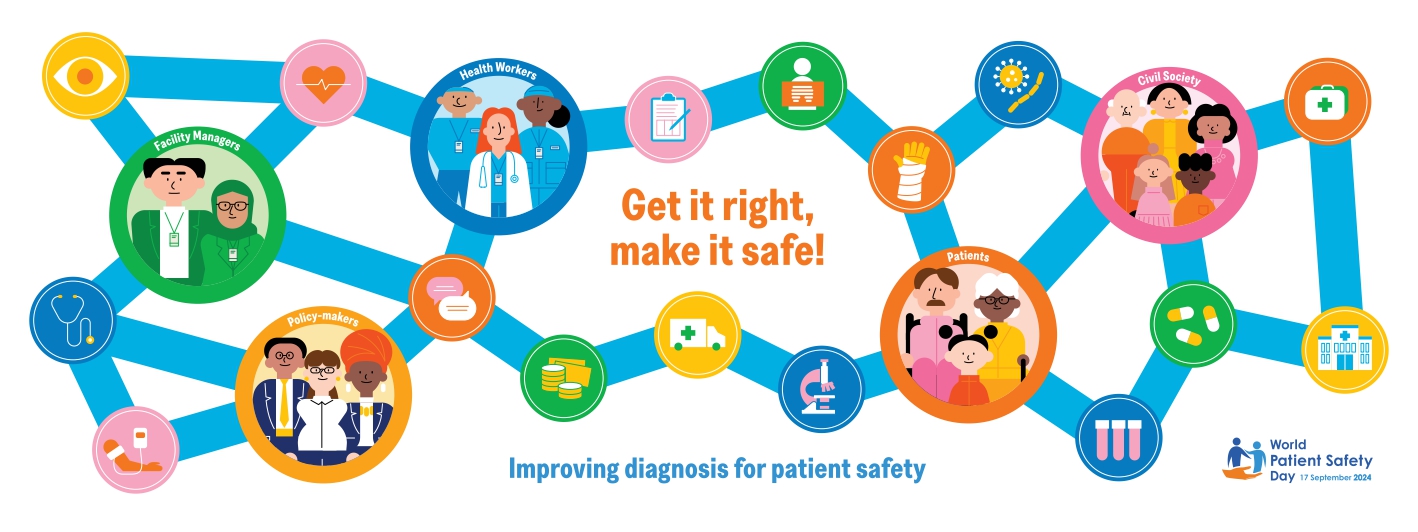
This year’s World Patient Safety Day theme is “Improving diagnosis for patient safety” with the slogan “Get it right, make it safe!”. The theme is a timely reminder on the critical importance of correct and timely diagnosis in ensuring patient safety and improving health outcomes.
A diagnostic error is the failure to establish a correct and timely explanation of a patient’s health problem, which can include delayed, incorrect, or missed diagnoses, or a failure to communicate that explanation to the patient.
Diagnostic errors can occur at any stage of a patient’s journey. From patient history and examination, diagnostic testing and interpretation to communicating results, final diagnosis, treatment plan, follow-up and re-evaluation.
According to WHO, the magnitude of diagnostic errors is profound, accounting for nearly 16% of preventable harm across health systems. Inefficient communication, lack of trained staff, equipment failure and missing details in medical history are some of the main causes of diagnostic errors.
Table of Contents
8 Ways to Improve Diagnostic Safety
Diagnostic safety can be significantly improved by addressing the systems-based issues and cognitive factors that can lead to diagnostic errors. Systemic factors are organizational vulnerabilities that predispose to diagnostic errors, including communication failures between health workers or health workers and patients, heavy workloads, and ineffective teamwork. Cognitive factors involve clinician training and experience as well as predisposition to biases, fatigue and stress.
Healthcare organizations can adopt the following strategies to enhance diagnostic safety:
- Enhance Communication and Teamwork
- Interdisciplinary collaboration: Encourage collaboration between different healthcare professionals (doctors, nurses, specialists, etc.) to reduce communication gaps and promote comprehensive diagnostic assessments.
- Clear documentation: Standardize and improve the accuracy of medical records, ensuring that key diagnostic information is shared effectively across the care team.
- Promote Diagnostic Error Awareness
- Training programs: Educate healthcare professionals about common diagnostic pitfalls, cognitive biases, and how to avoid them. Train staff in the importance of considering a broad differential diagnosis and avoiding premature closure.
- Diagnostic timeouts: Encourage the practice of “diagnostic timeouts,” where healthcare providers pause during complex cases to reconsider alternative diagnoses or seek second opinions.
- Foster a Culture of Safety
- Encourage error reporting: Create a non-punitive environment where health workers feel comfortable reporting diagnostic errors and near misses. Anonymize reports and use them for learning and system improvement.
- Root Cause Analysis: Regularly conduct root cause analyses (RCA) on diagnostic errors to identify systemic issues and areas for improvement.
- Standardize Diagnostic Processes
- Use checklists: Utilize diagnostic checklists for common conditions or clinical scenarios to reduce errors of omission.
- Structured handoffs: Standardize handoff processes between providers to ensure that critical diagnostic information is communicated during transitions in care (e.g., shift changes, transfers).
- Improve Access to Diagnostic Tests and Follow-Up
- Timely testing: Ensure patients have timely access to appropriate diagnostic tests. This includes optimizing lab workflows and reducing delays in imaging, biopsies, and other testing procedures.
- Close follow-up: Implement systems to ensure test results are reviewed promptly and that patients are notified and followed up on, especially for abnormal results. Ensure follow-up appointments are scheduled when necessary.
- Encourage Patient Engagement
- Shared decision-making: Engage patients in their diagnostic process by clearly explaining their condition, the reasoning behind diagnostic choices, and the uncertainty that might exist. Encourage patients to ask questions and provide feedback.
- Educational tools: Provide patients with educational resources that help them understand their symptoms, potential diagnoses, and when to seek further medical attention.
- Adopt Technology-based Solutions
- Integrate Clinical Decision Support System (CDSS): Implement clinical decision support tools that provide diagnostic suggestions, reminders, and alerts based on patient data and clinical guidelines. These systems help reduce cognitive overload and alert physicians to possible diagnoses they might overlook.
- Interoperability: Improve the interoperability of electronic health records (EHRs) to ensure that diagnostic data from different systems (e.g., labs, radiology, and previous health records) are easily accessible to providers.
- Continuous Monitoring and Feedback
- Diagnostic performance metrics: Track diagnostic performance using metrics like diagnostic accuracy, patient outcomes, and feedback loops. Use this data for quality improvement initiatives.
- Peer review: Implement regular peer review processes to evaluate the accuracy of diagnostic decisions and encourage continuous learning.
Objectives of World Patient Safety Day 2024
- Raise global awareness of errors in diagnosis contributing to patient harm and emphasize the pivotal role of correct, timely and safe diagnosis in improving patient safety.
- Give prominence to diagnostic safety in patient safety policy and clinical practice at all levels of health care.
- Foster collaboration among policymakers, health care leaders, health workers, patient organizations, and other stakeholders in advancing correct, timely and safe diagnosis.
- Empower patients and families to actively engage with health workers and health care leaders to improve diagnostic processes.
Call to Action
World Patient Safety Day is an opportunity for healthcare organizations to organize safety campaigns to promote awareness on diagnostic safety. Make urgent and concerted efforts to reduce diagnostic errors through the strategies and interventions outlined above.
For health workers, you can improve diagnostic accuracy by keeping your skills up to date, being aware of biases, consulting peers when in doubt, engaging with patients, communicating clearly and being effective team players.
Download Posters and Other Campaign Material
As a patient safety advocate, QUASR is re-sharing WHO’s campaign materials on this year’s WPSD theme “Improving Diagnosis for Patient Safety”. You may click the link below to download and use them for your safety and quality improvement campaigns.






